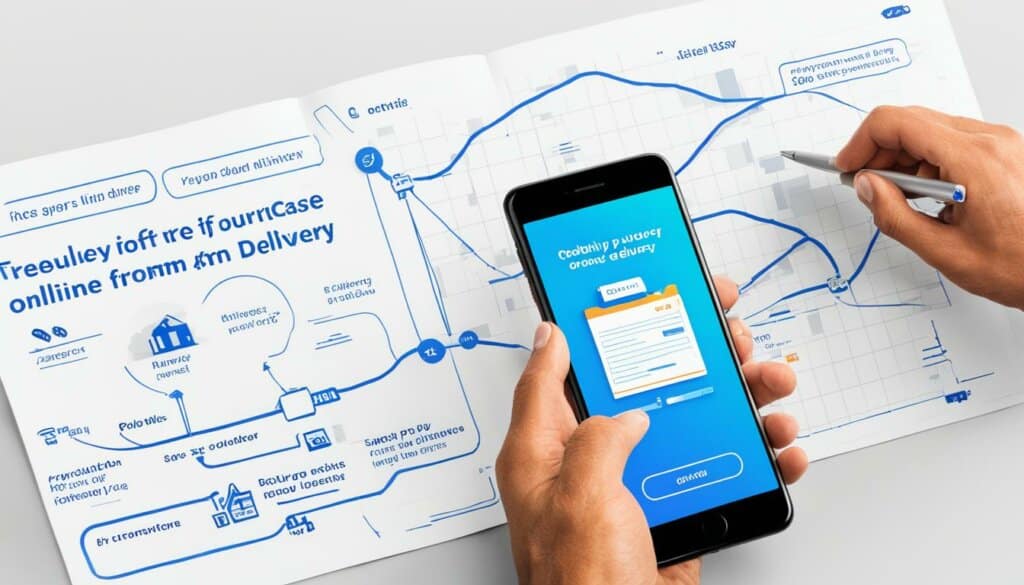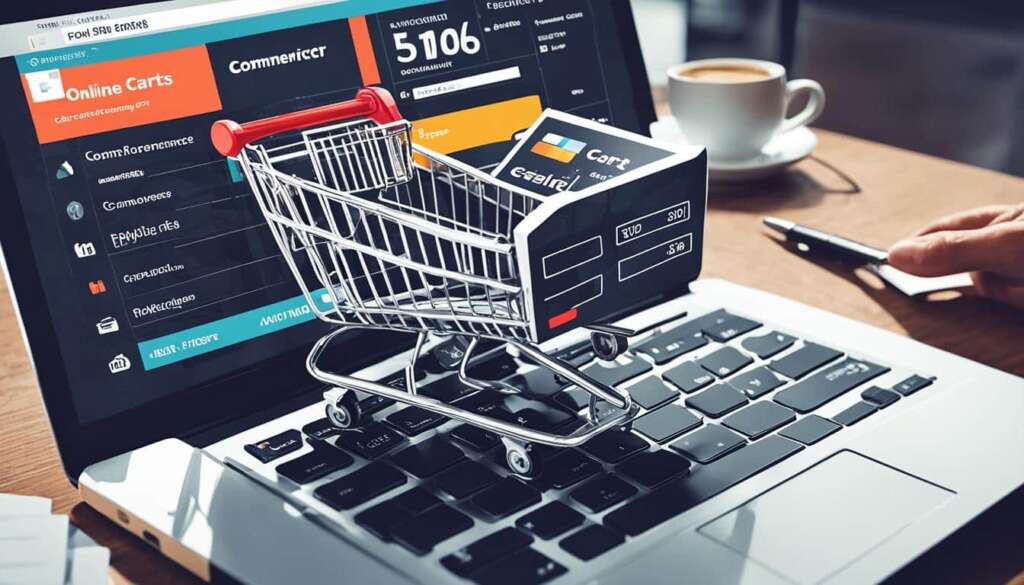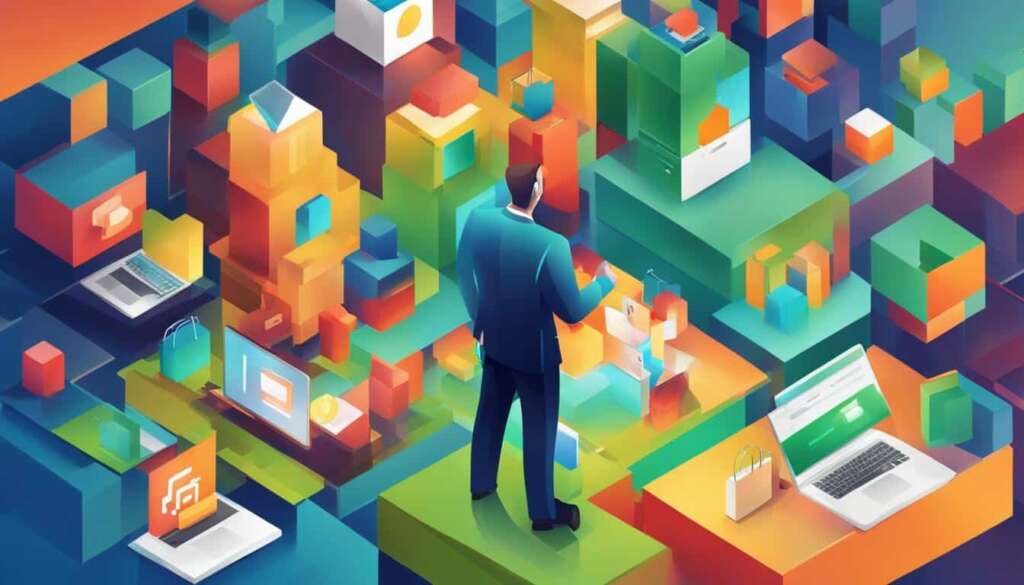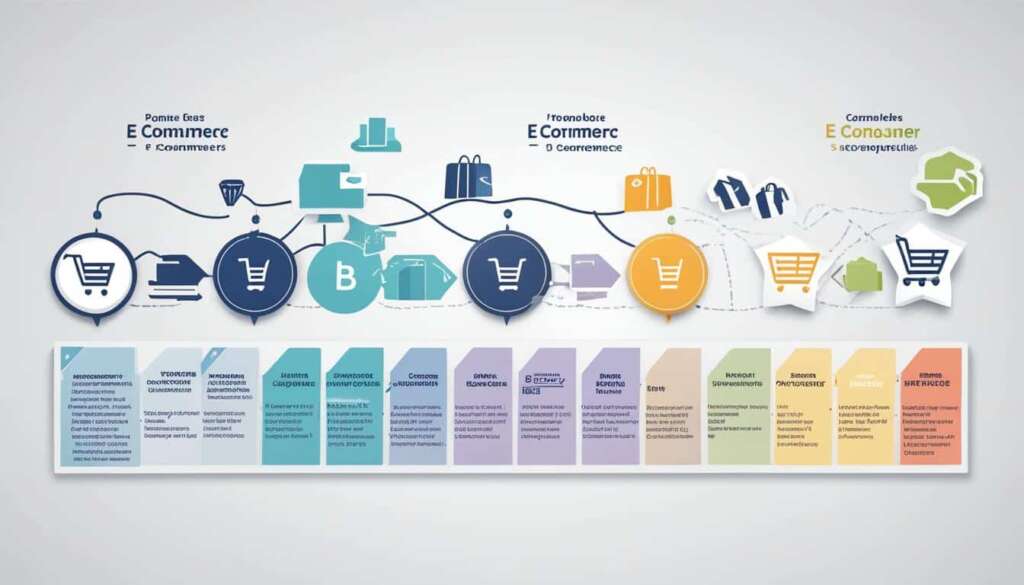Table of Contents
E-commerce, or electronic commerce, refers to the buying and selling of goods and services over an electronic network, primarily the internet. It encompasses different types of transactions, including business-to-business (B2B), business-to-consumer (B2C), consumer-to-consumer (C2C), and consumer-to-business (C2B). E-commerce has seen significant growth over the years, with platforms like Amazon and eBay contributing to the rise of online retail. It offers several advantages, including convenience, a wide selection of products, and international reach.
What is E-commerce?
E-commerce, short for electronic commerce, refers to the process of buying and selling goods and services through electronic networks, primarily the internet. It has revolutionized the way businesses operate and has become a prominent driver of global trade. With the advent of various electronic channels such as websites, social media, and online marketplaces, e-commerce facilitates transactions between businesses, consumers, and individuals.
E-commerce can be classified into different types based on the parties involved. These include:
- B2B (Business-to-Business) – Involves transactions between businesses, such as a manufacturer purchasing raw materials from a supplier.
- B2C (Business-to-Consumer) – Involves businesses selling products or services directly to consumers, like an online clothing retailer selling clothes to customers.
- C2C (Consumer-to-Consumer) – Involves consumers trading products or services with each other, such as individuals selling second-hand items on an online marketplace.
- C2B (Consumer-to-Business) – Involves consumers making their products or services available for businesses to purchase, like a freelance writer offering content writing services to businesses.
- B2A (Business-to-Administration) – Involves transactions between businesses and government bodies, such as a company paying taxes to the government online.
- C2A (Consumer-to-Administration) – Involves transactions between consumers and government bodies, like an individual renewing their driver’s license online.
E-commerce has transformed the way businesses reach customers and conduct transactions. It provides convenience, accessibility, and a global reach that traditional brick-and-mortar stores cannot match. By leveraging electronic channels, businesses can expand their customer base and offer a wide range of products or services.
“E-commerce has revolutionized the way businesses operate, enabling seamless transactions between businesses, consumers, and individuals.”
The Growth of E-commerce
In recent years, e-commerce has experienced significant growth fueled by advancements in technology and consumer preferences for online shopping. The rise of internet usage and the proliferation of smartphones have contributed to the expansion of e-commerce platforms and marketplaces.
According to Statista, global e-commerce sales amounted to approximately $4.28 trillion in 2020, and this number is projected to reach around $5.4 trillion in 2022. This substantial growth demonstrates the increasing popularity and importance of e-commerce in the modern business landscape.
How Does E-commerce Work?
E-commerce, or electronic commerce, operates through a series of interconnected processes and operations. By leveraging electronic channels, buyers and sellers are seamlessly connected, creating a virtual marketplace that facilitates online transactions.
Customers play a crucial role in the e-commerce process. They use their devices, such as computers, smartphones, or tablets, to access online stores, where they can browse a wide range of products or services and place orders with just a few clicks.
The order journey begins with the communication between the customer’s web browser and the server hosting the e-commerce website. This exchange of data establishes a connection and ensures secure communication throughout the transaction.
The data relayed during the order process is then transmitted to the order manager and various databases, where it is organized and stored. These databases contain crucial information, such as inventory levels, customer details, and transaction history.
Once the order is confirmed, payment processing comes into play. This stage involves secure and encrypted payment gateways that authorize and verify the transaction before transferring funds from the customer’s account to the merchant’s account.
After payment, the next step in e-commerce operations is shipping or order fulfillment. Depending on the nature of the business, this can involve packaging and dispatching physical products or delivering digital goods such as software or media files. The e-commerce platform or seller takes responsibility for ensuring that the products reach the customers within the stipulated time frame and in optimal condition.
E-commerce platforms and tools vary, catering to different business models and requirements. From established online marketplaces like Amazon and eBay to software-as-a-service tools and open-source platforms managed by companies, e-commerce operations are supported by a diverse ecosystem that empowers businesses to connect with customers worldwide.
“E-commerce operates through a series of interconnected processes and operations, from browsing products and placing orders to secure payment processing and order fulfillment.” – E-commerce Specialist
Understanding how e-commerce works is vital for both businesses and consumers. Regardless of their roles in the transaction, it enables them to navigate the digital landscape with ease and capitalize on the advantages that e-commerce offers.
Comparison of E-commerce Platforms
| E-commerce Platform | Features | Supported Business Models |
|---|---|---|
| Amazon | Robust infrastructure, global reach, customer reviews, fulfillment services | B2C, B2B |
| eBay | Auction-style listings, seller feedback, buyer protection programs | B2C, C2C |
| Shopify | Easy setup, customizable themes, integrated payment gateways | B2C, C2C |
| Magento | Highly customizable, scalable, advanced marketing and SEO tools | B2C, B2B |
The table above provides a comparison of popular e-commerce platforms, showcasing their key features and supported business models. Businesses can choose the platform that aligns with their specific needs and goals, enabling them to establish a strong online presence and drive e-commerce success.

Types of E-commerce
E-commerce encompasses various business models, each serving a specific purpose in the electronic commerce landscape. Understanding these different types is crucial for businesses looking to establish their online presence and cater to their target audience effectively.
B2B (Business-to-Business)
In B2B e-commerce, businesses engage in transactions with other businesses. This model involves the exchange of products, services, or information between companies. B2B e-commerce often involves bulk orders, long-term partnerships, and complex negotiation processes.
B2C (Business-to-Consumer)
B2C e-commerce focuses on businesses selling products or services directly to consumers. This is the most common type of e-commerce, encompassing online retail platforms that cater to individual customers. B2C e-commerce platforms offer convenience, a wide variety of products, and personalized shopping experiences.
C2C (Consumer-to-Consumer)
C2C e-commerce allows consumers to trade products or services directly with each other. Online marketplaces and classified ads websites facilitate this type of e-commerce, enabling individuals to sell their used items or provide services to other consumers. This model promotes peer-to-peer interaction and fosters trust within the consumer community.
C2B (Consumer-to-Business)
C2B e-commerce reverses the traditional business-consumer relationship. In this model, consumers make their products or services available for businesses to purchase. Examples include freelancers, influencers, or content creators offering their skills or content to businesses in exchange for compensation. C2B e-commerce enables businesses to tap into the expertise and creativity of individuals.
B2A (Business-to-Government)
B2A e-commerce involves transactions between businesses and government bodies. This model includes government procurement systems and online platforms where businesses can submit proposals or bids for government contracts. B2A e-commerce streamlines the process of interacting with government agencies, making it more efficient and transparent.
C2A (Consumer-to-Government)
C2A e-commerce occurs when consumers engage in transactions with government bodies. This includes activities such as paying taxes, renewing licenses, or accessing government services online. C2A e-commerce reduces bureaucratic delays and offers convenience to citizens, simplifying their interactions with government agencies.
Understanding the different types of e-commerce allows businesses to tailor their online strategies, target the right audience, and optimize their operations. It’s important to select the most suitable model based on business goals, customer needs, and industry dynamics.
Advantages of E-commerce
E-commerce, or electronic commerce, offers numerous benefits for businesses and consumers alike. Let’s explore some of the key advantages:
- Around-the-Clock Availability: One of the significant advantages of e-commerce is that it allows businesses to operate 24/7. Unlike traditional physical stores with fixed operating hours, online stores are accessible at any time, providing convenience for customers and potential sales opportunities for businesses even outside regular business hours. This flexibility caters to the needs of customers who may have hectic schedules or reside in different time zones.
- Speed of Access: With just a few clicks, customers can access online stores and browse through a wide selection of products. They can quickly find what they need, compare prices, read reviews, and make informed purchasing decisions without having to visit multiple physical stores. This accessibility and convenience save time and effort for both businesses and consumers, eliminating the constraints of traveling to physical locations.
- Wide Selection of Products: E-commerce offers an extensive range of products from various brands and sellers, often more than what physical stores can offer due to space limitations. Customers can explore diverse options, sizes, colors, and variations, allowing them to find exactly what they’re looking for. The ability to cater to niche markets and provide specialized products is a distinct advantage of online stores.
- Easy Accessibility: The internet has drastically simplified the process of accessing e-commerce platforms. Customers can use their smartphones, tablets, or computers with internet connectivity to access online stores from anywhere, whether at home, work, or on the go. This accessibility eliminates geographic barriers and brings products to customers’ fingertips, streamlining the shopping experience.
- International Reach: E-commerce transcends borders, enabling businesses to reach customers worldwide. Online stores have the potential to attract a global customer base, expand market reach, and tap into new opportunities. This international presence allows businesses to diversify their customer base, increase sales, and participate in cross-border trade without establishing physical locations in each target market.
- Lower Cost Compared to Physical Stores: Operating an e-commerce business often incurs lower costs compared to traditional brick-and-mortar stores. Online retailers can avoid expenses such as rent, utilities, display materials, and staff for physical locations. These cost savings can be passed on to customers, resulting in lower prices for products. Additionally, e-commerce eliminates the need for inventory storage in physical stores, reducing overhead costs.
- Personalization and Product Recommendations: E-commerce platforms leverage customer data and advanced analytics to personalize the shopping experience. By analyzing browsing history, purchase behavior, and demographic information, businesses can recommend relevant products and offer personalized promotions to customers. This level of personalization enhances customer satisfaction, encourages repeat purchases, and increases customer loyalty.
Overall, e-commerce brings convenience, accessibility, a wide range of products, and cost savings for businesses and consumers. With its ability to operate around the clock and reach customers globally, e-commerce has revolutionized the retail industry and continues to reshape the way we shop.
E-commerce Advantages at a Glance
| Advantages | Explanation |
|---|---|
| Around-the-Clock Availability | Online stores operate 24/7, providing convenience and sales opportunities outside regular business hours. |
| Speed of Access | Customers can quickly access online stores, browse products, compare prices, and make informed decisions. |
| Wide Selection of Products | E-commerce offers a diverse range of products, catering to various needs and preferences. |
| Easy Accessibility | Customers can access online stores from anywhere using their devices with internet connectivity. |
| International Reach | E-commerce enables businesses to reach customers worldwide and participate in cross-border trade. |
| Lower Cost Compared to Physical Stores | Operating online stores incurs lower expenses, resulting in cost savings for businesses and potentially lower prices for customers. |
| Personalization and Product Recommendations | E-commerce platforms leverage customer data to provide personalized recommendations, enhancing the shopping experience. |
Disadvantages of E-commerce
While e-commerce offers numerous advantages, it also comes with a set of drawbacks that should be considered. Understanding these disadvantages is crucial for businesses and consumers alike.
Limited Customer Service
One major disadvantage of e-commerce compared to physical stores is the lack of face-to-face interaction and personalized assistance. Online shoppers often miss the opportunity to engage with sales associates who can provide immediate answers to their questions, offer guidance, and ensure a satisfactory shopping experience.
Inability to Physically Experience Products
Unlike physical stores, e-commerce platforms do not allow customers to see, touch, or try out products before making a purchase. This limitation can lead to uncertainty or dissatisfaction with the product received, as online shoppers have to rely solely on product descriptions, images, and reviews.
Wait Time for Product Shipping
Another drawback of e-commerce is the wait time for product delivery. Unlike physical stores where customers can immediately take their purchases home, online shoppers have to wait for their products to be shipped. This delay can be frustrating, especially when immediate gratification is desired.
Security Issues
E-commerce transactions require the sharing of personal and financial information online, making security a concern for both businesses and consumers. Cybercriminals may attempt to exploit vulnerabilities in e-commerce platforms to gain access to sensitive data, potentially leading to identity theft or financial losses.
| Disadvantages of E-commerce |
|---|
| Limited customer service compared to physical stores |
| Inability to physically experience products |
| Wait time for product shipping |
| Security issues |

History of E-commerce
E-commerce has a rich history that dates back to the 1960s, well before the widespread use of the internet. It all started with the development of the Electronic Data Interchange (EDI), a system that enabled companies to exchange business documents electronically. EDI played a crucial role in streamlining document transfers between businesses, paving the way for the evolution of e-commerce.
However, it wasn’t until 1994 that the first online transaction occurred, marking a significant milestone in the history of e-commerce. A man by the name of Phil Brandenberger sold a CD by the band Sting to a friend named Dan Kohn over the internet. This groundbreaking transaction proved that the internet could be used for commercial purposes and set the stage for the rapid growth of e-commerce.
Since that first online transaction, e-commerce has continued to evolve and transform the way we buy and sell goods and services. Major companies like Amazon, Alibaba, eBay, and Etsy have emerged as dominant players in the e-commerce industry, reshaping the retail landscape and challenging traditional brick-and-mortar stores.
The growth of e-commerce has been fueled by several factors. Firstly, the widespread use of the internet has provided a platform for businesses to reach global audiences and tap into previously untapped markets. Additionally, the rise of social media has played a significant role in driving e-commerce growth, with businesses utilizing these platforms to advertise and sell their products.
Furthermore, the introduction of services like free shipping has further propelled the growth of e-commerce. Offering free shipping has become a common strategy for e-commerce businesses to attract customers, making online shopping more convenient and affordable.
Overall, the history of e-commerce is a testament to the continuous evolution of technology and its impact on the way we conduct business. From the early days of EDI to the rise of online giants like Amazon, e-commerce has revolutionized the retail industry and provided consumers with unprecedented convenience and access to a wide range of products.
Conclusion
E-commerce, or electronic commerce, has revolutionized the way businesses operate and has become an integral part of global trade. It involves the buying and selling of goods and services over an electronic network, primarily the internet. The convenience, wide selection of products, and international reach offered by e-commerce have made it a preferred method for both businesses and consumers.
One of the key advantages of e-commerce is its around-the-clock availability, allowing customers to shop whenever and wherever they please. Additionally, e-commerce offers lower operating costs compared to physical stores, enabling businesses to offer competitive prices. However, it is important to acknowledge the limitations of e-commerce, such as limited customer service and the inability to physically experience products before purchase.
Despite the challenges, e-commerce continues to thrive and shape the modern business landscape. With advancements in technology and the increasing acceptance of online shopping, the future of e-commerce looks promising. As businesses and consumers adapt to the digital age, e-commerce will undoubtedly play a crucial role in the world of retail and commerce.
FAQ
What is e-commerce?
E-commerce, or electronic commerce, refers to the buying and selling of goods and services over an electronic network, primarily the internet.
How does e-commerce work?
E-commerce operates by connecting buyers and sellers through electronic channels such as websites, social media, and online marketplaces. Customers can access online stores, browse products or services, and place orders. The order is then processed through various steps, including communication between the customer’s web browser and the e-commerce website’s server, data relayed to the order manager and databases, payment processing, and shipping or fulfillment of products.
What are the types of e-commerce?
E-commerce can be classified into different types based on the parties involved. These include B2B (business-to-business), B2C (business-to-consumer), C2C (consumer-to-consumer), C2B (consumer-to-business), B2A (business-to-administration), and C2A (consumer-to-administration).
What are the advantages of e-commerce?
E-commerce offers several advantages, including around-the-clock availability, a wide selection of products, easy accessibility, international reach, lower costs compared to physical stores, and the ability to personalize marketing strategies.
What are the disadvantages of e-commerce?
Some disadvantages of e-commerce include limited customer service compared to physical stores, the inability to see or touch a product before purchase, shipping wait times, and security concerns.
What is the history of e-commerce?
E-commerce has a rich history that predates the internet. It started with the Electronic Data Interchange in the 1960s and has evolved significantly since then, with major players like Amazon, Alibaba, eBay, and Etsy shaping the industry.







